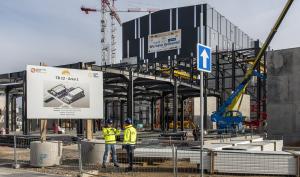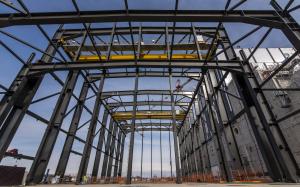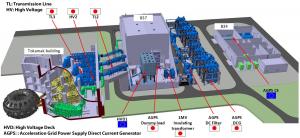Seule la foudre fait mieux
Celui du JET européen, le plus gros tokamak en exploitation dans le monde, génère une tension électrique de l'ordre de 130 000 volts. Celui du JT-60SA euro-japonais atteindra 500 000 volts pendant quelques minutes. Dans le cas d'ITER, il faudra générer une tension d'un million de volts (1 MV) sur des durées de l'ordre de l'heure.
Les deux halls qui accueilleront le système de chauffage par injection de neutres seront quasiment vides, à l'exception de deux éléments verticaux singuliers : un caisson métallique haute tension de 9 mètres de hauteur placé sur des supports hauts de 6 mètres, isolés du sol, ainsi qu'une traversée électrique de 16 mètres de hauteur pour le raccordement d'un transformateur géant dont le corps principal se trouve à l'extérieur du bâtiment. La nature de ces équipements hors norme a imposé des contraintes très strictes pour la conception intérieure du bâtiment. Pour prévenir la formation d'arcs électriques, les éléments situés à l'intérieur des halls ne doivent présenter aucun angle vif ou structure saillante et, pour des raisons de sécurité, chaque caisson est entouré d'une « zone d'exclusion » de cinq mètres de rayon. Inutile de préciser que personne ne pourra pénétrer dans le bâtiment pendant l'exploitation.
Moins spectaculaire mais non moins stratégique, le bâtiment d'alimentation électrique du système d'injection de neutres recevra les équipements (transformateurs « secs », convertisseurs de puissance, redresseurs, onduleurs et autres dispositifs spéciaux) connectés aux caissons métalliques haute tension par l'intermédiaire de dix transformateurs élévateurs installés entre les bâtiments. Comme de nombreux éléments de l'installation ITER, le système d'injection de neutres fonctionne avec du courant continu. Mais contrairement aux aimants, par exemple, qui utilisent un courant de forte intensité et une basse tension, le système d'injection de neutres nécessite un courant de basse intensité et une très haute tension.
Cette différence ne réduit pas la taille des équipements pour autant. Fournis par le Japon, les dix générateurs de courant continu de 200 kV (constitués d'un transformateur élévateur connecté à un redresseur à diodes pour obtenir 200 kV DC en sortie), chacun installé dans son box isolé par des murs coupe-feu, sont aussi massifs que les transformateurs géants du réseau pulsé de la sous-station électrique d'ITER. Là aussi, le dimensionnement est déterminé par les impératifs d'isolation, en particulier par la quantité d'huile présente dans chaque transformateur (jusqu'à 75 000 litres). Trois transformateurs de plus petite taille seront affectés au système d'injection de neutres du système de diagnostics.
Seules les forces brutes de la nature sont capables de produire des tensions plus élevées que celles de l'installation d'alimentation électrique du système d'injection de neutres d'ITER. Mais les impacts de foudre ne durent que quelques millisecondes, alors que la formidable installation d'ITER est conçue pour alimenter les injecteurs en continu lors de décharges de plasma qui pourront durer une heure. Il n'existe aucune installation équivalente dans le monde.




